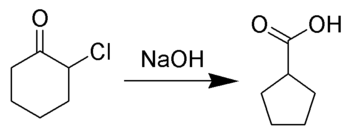| Favorskii rearrangement | |
|---|---|
| Named after | Alexei Yevgrafovich Favorskii |
| Reaction type | Rearrangement reaction |
| Identifiers | |
| Organic Chemistry Portal | favorsky-reaction |
| RSC ontology ID | RXNO:0000385 |
The Favorskii rearrangement is principally a rearrangement of cyclopropanones and α-halo ketones that leads to carboxylic acid derivatives. In the case of cyclic α-halo ketones, the Favorskii rearrangement constitutes a ring contraction. This rearrangement takes place in the presence of a base, sometimes hydroxide, to yield a carboxylic acid, but usually either an alkoxide base or an amine to yield an ester or an amide, respectively. α,α'-Dihaloketones eliminate HX under the reaction conditions to give α,β-unsaturated carbonyl compounds.[1][2][3][4][5] Note that trihalomethyl ketone substrates will result in haloform and carboxylate formation via the haloform reaction instead.

- ^ Cope, Arthur (1960). Organic Reaction Volume XI (1 ed.). New York: Wiley-Interscience. doi:10.1002/jps.2600500225. ISBN 9780471171270.
- ^ Wohllebe, J.; Garbisch, E. W. (1977). "Ring Contraction via a Favorskii-Type Rearrangement: Cycloundecanone". Organic Syntheses. 56: 107. doi:10.15227/orgsyn.056.0107; Collected Volumes, vol. 6, p. 368.
- ^ Shioiri, Takayuki; Kawai, Nobutaka (1978). "New methods and reagents in organic synthesis. 2. A facile conversion of alkyl aryl ketones to α-arylalkanoic acids using diphenyl phosphorazidate. Its application to a new synthesis of ibuprofen and naproxen, nonsteroidal antiinflammatory agents". J. Org. Chem. 43 (14): 2936–2938. doi:10.1021/jo00408a049.
- ^ Hamada, Yasumasa; Shioiri, Takayuki (1982). "Cycloundecanecarboxylic Acid". Organic Syntheses. 62: 191. doi:10.15227/orgsyn.062.0191; Collected Volumes, vol. 7, p. 135.
- ^ Goheen, D. W.; Vaughan, W. R. (1963). "Cyclopentanecarboxylic acid, methyl ester". Organic Syntheses. 39: 37. doi:10.15227/orgsyn.039.0037; Collected Volumes, vol. 4, p. 594.